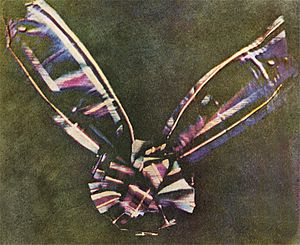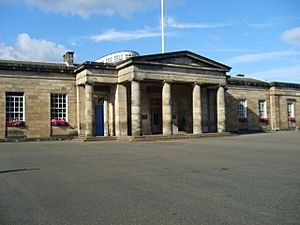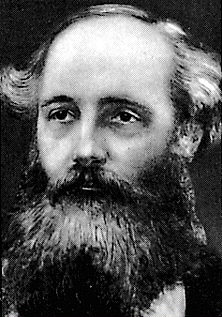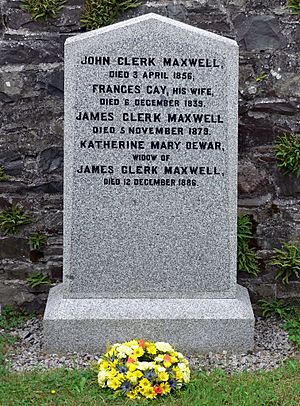James Clerk Maxwell facts for kids
Quick facts for kids
James Clerk Maxwell
|
|
|---|---|
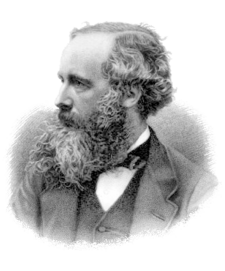
James Clerk Maxwell (1831–1879)
|
|
| Born | 13 June 1831 Edinburgh, Scotland
|
| Died | 5 November 1879 (aged 48) Cambridge, England
|
| Resting place | Parton, Dumfries and Galloway |
| Nationality | Scottish |
| Citizenship | British |
| Alma mater | University of Edinburgh University of Cambridge |
| Known for | Maxwell's equations Maxwell relations Maxwell distribution Maxwell's demon Maxwell's discs Maxwell speed distribution Maxwell's theorem Maxwell material Generalized Maxwell model Displacement current Maxwell coil Maxwell's wheel |
| Spouse(s) | Katherine Clerk Maxwell |
| Awards | Smith's Prize (1854) Adams Prize (1857) Rumford Medal (1860) Keith Prize (1869–71) |
| Scientific career | |
| Fields | Physics and mathematics |
| Institutions | Marischal College, Aberdeen King's College, London University of Cambridge |
| Academic advisors | William Hopkins |
| Notable students | George Chrystal Horace Lamb John Henry Poynting |
| Influences | Sir Isaac Newton, Michael Faraday |
| Influenced | Albert Einstein |
| Signature | |
 |
|
James Clerk Maxwell (June 13, 1831 – November 5, 1879) was a brilliant Scottish scientist. He worked in mathematical physics, which uses math to understand how the world works. His most famous discovery was bringing together electricity, magnetism, and light. He showed they are all parts of the same thing called electromagnetic radiation.
Maxwell's ideas, known as Maxwell's equations, were a huge step in physics. People called it the "second great unification" after Isaac Newton's work. This linking of light and electricity even led to predicting radio waves!
Maxwell also helped create the Maxwell–Boltzmann distribution. This helps describe how gases behave, like how fast their tiny particles move. He's also famous for showing the first lasting color photograph in 1861. He also did important work on how strong structures like bridges are.
His discoveries helped start modern physics. They laid the groundwork for ideas like special relativity and quantum mechanics. Many scientists think Maxwell was the most important 19th-century scientist for 20th-century physics. His work is often compared to that of Isaac Newton and Albert Einstein.
In a poll of 100 top physicists, Maxwell was voted the third greatest ever. Only Newton and Einstein were ranked higher. Einstein himself called Maxwell's work "the most profound and the most fruitful" in physics since Newton's time.
Contents
Early Life and School Days
James Clerk Maxwell grew up in a religious family. His mother, Frances, taught him at home when he was very young. This was common for women in the Victorian era. By age eight, he knew long parts of the Bible by heart. Sadly, his mother died when he was eight years old.
His father and aunt Jane then looked after his education. His first tutor was not very good and treated him harshly. This tutor was soon let go. A big moment for young James was seeing a demonstration of electric power and magnetic force. This happened in 1842 and really sparked his interest.
Maxwell was sent to the famous Edinburgh Academy. He stayed with his aunt Isabella during school terms. His older cousin, Jemima, encouraged his love for drawing. James was used to living quietly on his family's country estate. So, he didn't fit in well at school at first. On his first day, he wore homemade shoes and a tunic. This led to other boys calling him "Daftie" (meaning silly).
Maxwell loved geometry from a young age. He even figured out regular polyhedra on his own before being taught about them. He didn't always focus on exams. But at 13, he won the school's math medal and top prizes for English and poetry.
His interests went far beyond what was taught in school. At just 14, he wrote his first scientific paper. In it, he described a way to draw mathematical curves using string. He also explored the properties of ellipses and other related curves. A professor named James David Forbes presented Maxwell's paper to the Royal Society of Edinburgh. Maxwell was too young to present it himself.
Later Life and Discoveries
In 1871, Maxwell returned to Cambridge. He became the first Cavendish Professor of Physics. He was in charge of setting up the Cavendish Laboratory. He oversaw everything from building the lab to buying all the equipment.
One of his last big contributions was editing the research of Henry Cavendish. This work looked at things like the density of the Earth and what water is made of.
Maxwell loved Scottish poetry. He knew many poems by heart and wrote his own. His most famous poem is Rigid Body Sings. It's based on a song by Robert Burns. People who knew Maxwell said he was very smart but also a bit socially awkward.
He was a religious man, a Presbyterian. In his later years, he became an Elder in the Church of Scotland.
Death and Lasting Impact
James Clerk Maxwell died in Cambridge on November 5, 1879. He was 48 years old. His mother had died at the same age from the same type of cancer. Even in his last weeks, he was very clear-headed and had an amazing memory.
Maxwell is buried at Parton Kirk. This is near where he grew up in Galloway. His friend, Professor Lewis Campbell, wrote a detailed book about his life in 1882. Maxwell's collected scientific papers were published in 1890.
Maxwell's Legacy and Honors
Maxwell's name is remembered in many ways:
- The maxwell (Mx) is a unit used to measure magnetic flux.
- The James Clerk Maxwell Prize in Plasma Physics is a major award.
- The IEEE Maxwell Award also honors him.
- Maxwell Montes is a mountain range on the planet Venus.
- The Maxwell Gap is a space in the Rings of Saturn.
- The James Clerk Maxwell Telescope is a huge telescope for studying space.
- The James Clerk Maxwell Building at the University of Edinburgh houses science departments.
- The James Clerk Maxwell building at King's College London is also named after him.
- The James Clerk Maxwell Science Centre is at the Edinburgh Academy.
- The Maxwell Centre at the University of Cambridge connects science and industry.
- A statue of him stands on George Street in Edinburgh.
- The company Nvidia named its "Maxwell" computer chip architecture after him.
- A planned sculpture called the Star of Caledonia will honor him.
- The ANSYS software for electromagnetic analysis is named Maxwell.
Images for kids
-
Clerk Maxwell's birthplace at 14 India Street in Edinburgh is now the home of the James Clerk Maxwell Foundation.
-
A young Maxwell at Trinity College, Cambridge, holding one of his color wheels.
-
Maxwell proved that the Rings of Saturn were made of numerous small particles.
-
James Clerk Maxwell and his wife by Jemima Blackburn.
-
Commemoration of Maxwell's equations at King's College. One of three identical IEEE Milestone Plaques.
-
James Clerk Maxwell by Jemima Blackburn.
See also
 In Spanish: James Clerk Maxwell para niños
In Spanish: James Clerk Maxwell para niños


